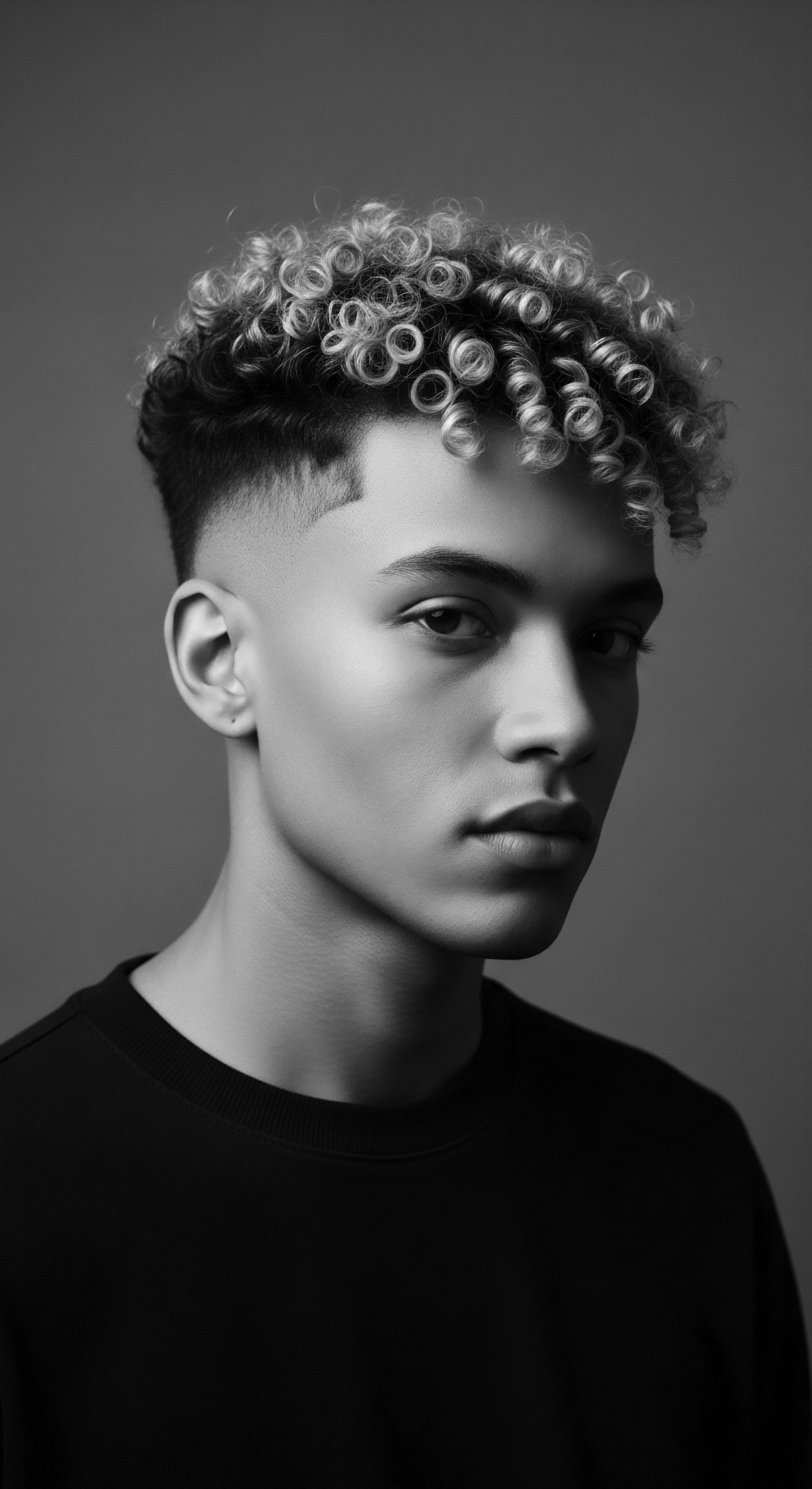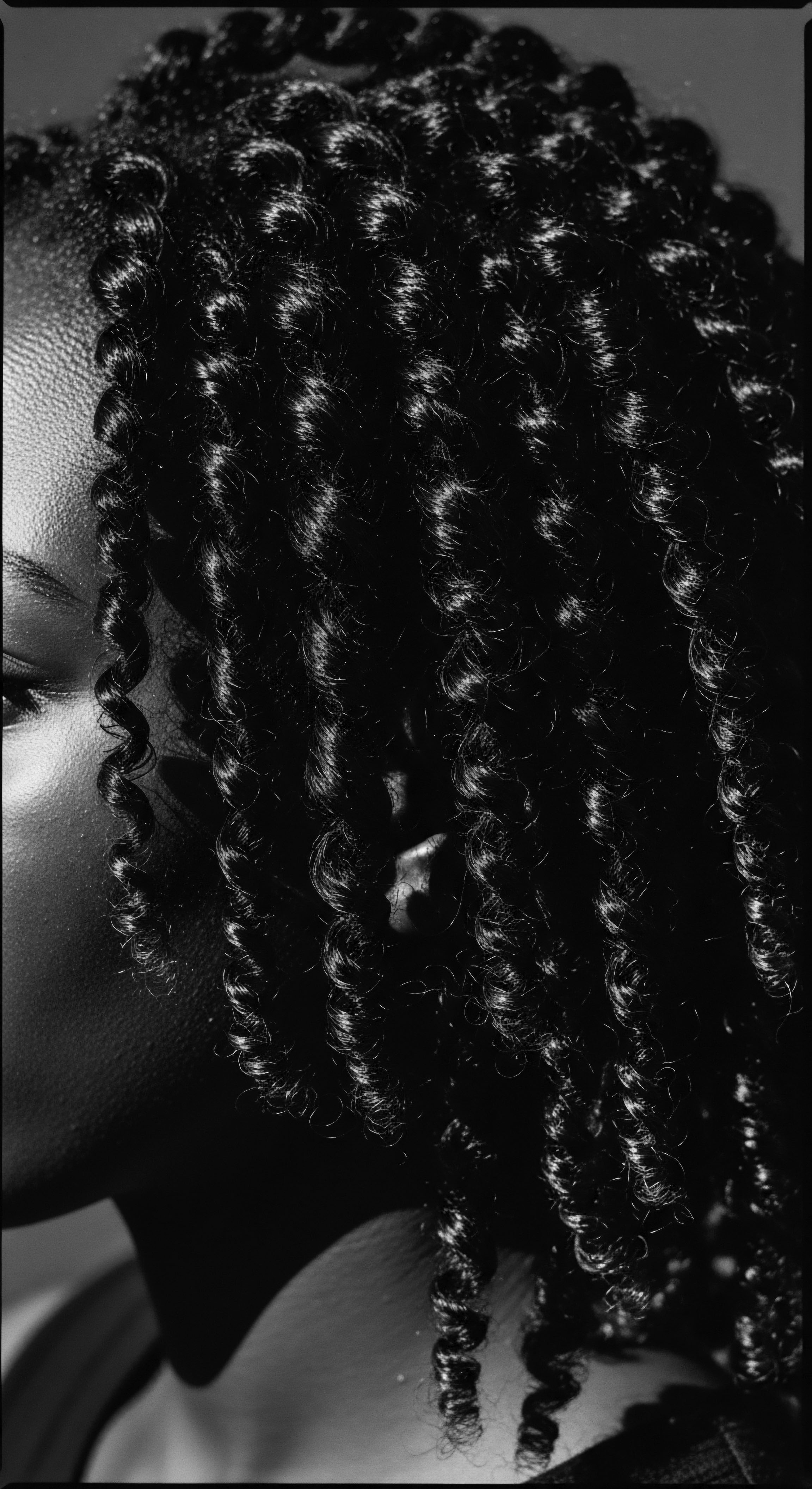
Roots
The story of textured hair is, at its very core, a profound meditation on ancestry, identity, and the enduring wisdom passed through generations. It is a chronicle whispered not merely through genes, but through the intentional acts of care and collective ritual. When we consider the historical role of communal cleansing rituals, we touch upon something far more fundamental than simple hygiene. These were not perfunctory acts; they were ceremonies of purification, connection, and spiritual renewal, deeply ingrained in the very heritage of communities, especially those of Black and mixed-race lineage.
From the ancient riverbanks of the Nile to the vibrant village squares of West Africa, and onward through the pathways of the diaspora, water, earth, and botanical blessings have long been held as sacred agents of renewal. Cleansing the hair, particularly the tightly coiled or luxuriously wavy strands that define so much of Black heritage, was often a collective endeavor. It involved hands, communal pots, and shared knowledge, transforming a practical need into a ceremonial affirmation of belonging. This collective engagement solidified the role of hair as a spiritual antenna, a vessel for ancestral memory, and a visible declaration of one’s place within the societal fabric.

Ancestral Understanding of Hair’s Vitality
For centuries, the physical reality of hair was inseparable from its spiritual and communal meaning. The scalp, the very ground from which the hair springs, was seen as a vital energetic nexus, a connection point between the individual and the cosmos, and crucially, between the living and their forebears. Cleansing rituals, then, were not just about removing dirt; they were about clearing energetic blockages, inviting blessings, and preparing the self for deeper spiritual engagement. They ensured the pathways of ancestral communication remained clear, allowing wisdom to flow freely.
Consider the very biology of textured hair, its unique helical structure, its often delicate outer cuticle. Ancestral practices instinctively understood the need for gentle, nourishing care. The ingredients used in these communal washes—clays, saponifying plants, herbal infusions—were chosen not only for their cleansing properties but for their ability to soothe, protect, and fortify the hair shaft and scalp. These were living formulations, often prepared fresh, their effectiveness stemming from a symbiotic relationship with nature.
Communal cleansing rituals were sacred acts, solidifying belonging and preparing individuals for deeper spiritual connections within their heritage.

The Intertwined Histories of Hair and Identity
The practice of communal hair cleansing also served as a powerful mechanism for transmitting cultural knowledge. Young hands learned from elder ones, observing the proper way to detangle, to apply botanical washes, to rinse thoroughly, and to protect the hair during the process. This was an oral tradition, a tactile education that reinforced familial bonds and community structures. The very act of washing another’s hair, especially within a group, built trust and intimacy, fostering a collective identity that transcended individual experience.
The knowledge embedded in these rituals extended to understanding the hair’s unique physiological needs. For instance, the natural oils produced by the scalp, which travel more slowly down the length of tightly coiled strands, were understood to need protection. Cleansing methods were developed to remove impurities without stripping away these vital emollients. This intuitive scientific understanding, honed over millennia, is a testament to the ancestral ingenuity that undergirds much of what we now affirm with modern scientific tools.
- Clay Washes ❉ Used across various African cultures, clays such as Rhassoul from Morocco or Bentonite were applied to hair and skin. These mineral-rich earths possess powerful absorptive qualities, drawing out impurities while often imparting beneficial minerals. Their gentle cleansing action was particularly suited to delicate textured strands, removing build-up without excessive stripping.
- Saponifying Plants ❉ Certain plant leaves, roots, or pods were bruised or boiled to create natural lathers. The soap berry tree (Sapindus mukorossi) or various species of Shikakai (Acacia concinna) in South Asia (with influence radiating into African trade routes) are prime examples. These natural cleansers offered a soft, conditioning wash, leaving hair manageable and preserving its natural moisture.
- Herbal Infusions ❉ Plants like hibiscus, rosemary, or nettle were steeped in water, creating rinses that not only cleansed but also stimulated the scalp, added shine, and strengthened hair. These infusions often carried symbolic meanings, aligning the cleansing with spiritual or medicinal purposes.
| Ancestral Practice Using natural clays for washing |
| Underlying Heritage Understanding Intuitive recognition of gentle purification and mineral enrichment for hair and scalp, preserving natural moisture. |
| Modern Scientific Link Clays possess cation exchange capacity, drawing impurities while leaving beneficial elements, and their mild pH can be compatible with the hair's natural acidity. |
| Ancestral Practice Incorporating herbal rinses |
| Underlying Heritage Understanding Belief in spiritual purification, stimulation of growth, and addition of natural sheen through botanical properties. |
| Modern Scientific Link Many herbs contain antioxidants, anti-inflammatory compounds, or mild astringents that can promote scalp health, improve circulation, and enhance hair's appearance. |
| Ancestral Practice Communal hair care sessions |
| Underlying Heritage Understanding Reinforcement of community bonds, intergenerational knowledge transfer, and collective identity formation through shared physical acts. |
| Modern Scientific Link Sociological and psychological studies affirm the importance of communal rituals in strengthening social cohesion, transmitting cultural norms, and fostering a sense of belonging. (Dubois, 1903) |
| Ancestral Practice The echoes of ancestral wisdom concerning cleansing remain strikingly relevant in our contemporary understanding of textured hair wellness. |

Ritual
The historical role of communal cleansing rituals extended far beyond simple hygiene, settling deeply into the very essence of social structure, spiritual practice, and the transmission of knowledge surrounding textured hair. These were moments of convergence, where the practical necessities of care intersected with profound cultural meaning. The practices themselves varied across regions and communities, yet a common thread of reverence for hair, as a sacred extension of self and ancestry, held them together.

The Architecture of Shared Cleansing Moments
Within many African societies, the act of hair washing was not a solitary affair conducted privately; it was often a communal endeavor, especially for women. Picture a gathering by a cool river, under the shade of a venerable tree, or within the privacy of a shared compound. Here, grandmothers, mothers, and daughters would engage in the meticulous process of cleansing, detangling, and preparing hair. Hands would move with practiced rhythm, the air alive with conversation, proverbs, and songs.
This was, in effect, a living classroom, where the intricate techniques of hair care were imparted through observation and direct participation. The younger generations learned the subtle art of handling kinky, coily, and wavy strands with a gentleness that respected their inherent structure.
The tools and ingredients used in these rituals were drawn directly from the earth and the knowledge accumulated over centuries. Sponges crafted from natural fibers, gourds for holding water or prepared washes, and various wooden combs fashioned to navigate tightly curled patterns were commonplace. The ingredients, as mentioned earlier, were often botanical—leaves, roots, barks, or seeds known for their saponifying, conditioning, or medicinal properties. The preparation of these cleansing agents itself often became part of the ritual, involving grinding, steeping, or boiling, often accompanied by specific chants or prayers, imbuing the concoctions with spiritual potency.
Hair cleansing rituals, often communal, were profound learning grounds, passing down intricate care techniques and cultural wisdom through generations.

Rituals of Passage and Identity Affirmation
Communal cleansing rituals frequently marked significant life stages or transitions, underscoring their role in solidifying identity and heritage. For example, among some West African ethnic groups, a young girl’s first comprehensive hair cleansing and styling might have been a ceremonial event, signifying her passage into adolescence. Similarly, cleansing rituals could precede marriages, births, or funerals, acting as a form of spiritual and physical preparation for new phases of life or mourning. In these contexts, the hair, once cleansed, was often adorned with specific styles, oils, or cowrie shells, each element carrying a particular symbolic meaning related to the individual’s new status or role within the community.
Consider the deep historical significance of hair care among the Wodaabe people of Niger, where the elaborate care and styling of hair, particularly among men, are integral to courtship rituals and expressions of beauty. While not strictly “cleansing” in the daily sense, the meticulous preparation and adornment of their long, braided hair forms part of a holistic ritualistic beauty practice that often begins with thorough washing and conditioning, signifying readiness for ceremonial appearance. This underscores how hair care, including cleansing, is intimately tied to public presentation and the reinforcement of cultural values and gender roles (Beckwith & Van Dyke, 1999).
The meticulous attention paid to hair during these communal moments also served a protective function. Beyond the physical removal of dirt, the act of washing and anointing the hair was believed to ward off negative spirits, evil intentions, or ill health. The hair, sitting atop the head—the seat of thought and spirit—was seen as a primary point of vulnerability and also of power.
Therefore, its ritualistic cleansing was a safeguarding measure, ensuring the individual remained in spiritual harmony and physical well-being. This belief system is a testament to the holistic approach to health and beauty prevalent in many ancestral traditions, where the physical, spiritual, and communal realms were inextricably linked.

Hair as a Canvas for Communal Identity
The transformation of cleansed hair into intricate styles during these communal gatherings was also a powerful act of collective artistry. Hairstyles could convey marital status, age, social rank, ethnic affiliation, or even one’s aspirations. The shared activity of styling reinforced these visual cues, ensuring that everyone understood the unspoken language of hair within the community. The careful sectioning, braiding, twisting, or coiling of hair was a communal performance, a physical manifestation of shared heritage and identity.
- Preparatory Herbal Brews ❉ Before actual washing, sometimes a warm herbal brew, like a decoction of baobab leaves or senna pods, would be applied to help loosen tangles and condition the hair. This step would often involve gentle massage, stimulating the scalp and preparing the strands for cleansing.
- Collective Cleansing ❉ Family members, typically women, would take turns washing each other’s hair, using naturally derived saponins or clays. This shared task allowed for thorough cleansing and scalp care, reinforcing bonds through touch and mutual care.
- Rinsing and Conditioning ❉ Hair would be rinsed with fresh water, often drawn from a nearby river or well, followed by applications of nourishing oils or infusions from plants like shea butter, palm oil, or castor beans. These emollients helped to seal moisture and protect the delicate hair structure.
- Protective Styling Initiation ❉ Immediately following cleansing, hair would often be sectioned and styled into intricate braids, twists, or cornrows. These styles served not only for aesthetic appeal but also as protective measures, preserving the integrity of the hair and signaling social status or community affiliation.

Relay
The historical role of communal cleansing rituals, particularly those tied to textured hair heritage, serves as a profound relay of cultural understanding, bridging the chasm between ancient practices and contemporary expressions of identity. These were not isolated occurrences but rather dynamic, living traditions that adapted and persisted, even through periods of profound societal upheaval and displacement. Understanding this continuity requires a sophisticated lens, one that acknowledges both the tangible acts of washing and the intangible transfer of ancestral wisdom and resilience.

Transmission of Knowledge Across Continents
The transatlantic slave trade, a period of immense rupture and devastation, could not entirely sever the delicate yet powerful connections to hair heritage. Enslaved Africans carried with them the memory of communal hair practices, often adapting them to new environments and scarce resources. The communal gathering for hair care, even under duress, transformed into a clandestine act of resistance and preservation of self. It was in these hidden moments that the heritage of cleansing and styling continued, transmitting vital cultural codes and resilience through shared touch and whispered instructions.
Consider the resilience of the cornrow , a style intrinsically linked to careful cleansing and sectioning. In the Caribbean and Americas, enslaved people used cornrows not only as a protective style but also, reportedly, to hide seeds for planting or as maps to freedom ( Byrd & Tharps, 2001). The very act of creating these intricate patterns, which necessitates clean, prepared hair, speaks to a continuity of cleansing traditions, albeit under drastically altered circumstances. The communal nature of styling, whether through necessity or defiance, preserved a vital aspect of heritage that began with the collective preparation of the hair itself.
The scientific underpinning of modern hair care, though often presented as novel, frequently mirrors the intuitive wisdom of ancestral practices. For instance, the emphasis on moisturizing cleansers for textured hair finds a direct echo in the historical use of saponifying plants that cleansed gently without stripping natural oils. The understanding that excessive manipulation harms delicate strands, a cornerstone of protective styling today, was lived knowledge in communities where careful, collective handling during cleansing and styling was the norm. This deep, practical wisdom was relayed through the generations, often without formal texts, solely through shared experience and observation.
The enduring power of communal cleansing rituals lies in their capacity to transmit culture and resilience across generations, adapting to new contexts while preserving ancestral knowledge.

Societal Structures and Hair Practices
The communal nature of hair cleansing rituals also played a significant role in reinforcing societal structures and collective identity within African and diasporic communities. Hair, being so visible and so susceptible to manipulation, became a potent medium for expressing group affiliation, status, and even dissent. Cleansing and styling together cemented these meanings. For instance, in some West African societies, elaborate hairstyles, achieved after meticulous washing and preparation, indicated a woman’s marriageability or her status as a mother.
In certain contexts, the person performing the hair cleansing and styling held a position of respect and authority. These were often elder women, repositories of knowledge and community wisdom. Their hands, engaged in the intimate act of hair care, were also passing down stories, proverbs, and moral lessons. The cleansing session became a forum for intergenerational dialogue, a space where the ethics of the community were reinforced alongside the techniques of hair care.

Challenges and Adaptations of Cleansing Heritage
With colonialism and the subsequent imposition of Eurocentric beauty standards, communal hair cleansing rituals, alongside traditional hairstyles, faced immense pressure. The introduction of harsh chemical hair straighteners and the promotion of “manageable” hair led to a period where many traditional practices were suppressed or devalued. Yet, the deep-seated heritage of hair care persisted, often in private family spaces. The cleansing ritual, though perhaps less publicly communal, continued within households, a quiet act of preserving a connection to ancestry against a backdrop of external pressures.
In contemporary times, there is a resurgence of interest in ancestral hair care practices. This revival is often framed as a reclamation of heritage, a conscious decision to connect with the wisdom of forebears. The understanding of what constitutes a “cleanse” for textured hair has evolved, yet the core principles—gentle treatment, nourishing ingredients, and respect for the hair’s natural state—remain resonant with ancestral approaches. The communal aspect, while perhaps less about physical gathering for washing, manifests in online communities, shared knowledge platforms, and collective celebrations of natural textured hair, creating a new kind of digital communal space for heritage preservation.
The shift from purely physical communal cleansing to broader expressions of shared care and affirmation represents a dynamic evolution of heritage. It demonstrates that the essence of these rituals—connection, learning, identity—can adapt to changing societal landscapes while retaining its fundamental power. The relay of this wisdom continues, not as a static historical artifact, but as a living, breathing testament to the enduring significance of textured hair.

Reflection
The echoes of communal cleansing rituals reverberate through the very soul of textured hair heritage, not as distant whispers from a forgotten past, but as a living resonance within our strands. What began as practical acts of purification, born from an innate understanding of nature and the human form, evolved into profound communal narratives. These rituals stand as a testament to the ingenious ways human societies preserved identity, transmitted invaluable knowledge, and forged unbreakable bonds, all centered around the sacred crown of the head.
The legacy of these ancestral practices encourages us to view hair not as a mere aesthetic accessory, but as a vital conduit of heritage. It prompts a deeper appreciation for the intuitive science of our forebears, whose meticulous care anticipated many modern trichological principles. In every gentle wash, every careful detangle, every thoughtful application of nature’s bounty, we can sense the tender thread of connection to those who came before us. This unbroken chain of knowledge, carried forward through the living library of our textured hair, speaks of resilience, adaptability, and enduring beauty.
As we navigate our contemporary hair journeys, the wisdom of communal cleansing rituals beckons us to consider the holistic dimensions of care. It invites a purposeful interaction with our strands, recognizing them as an outward manifestation of an inner lineage. This historical exploration affirms that the health and radiance of textured hair are not simply a personal pursuit but an ongoing conversation with heritage, a continuous reaffirmation of identity, and a celebration of the profound, luminous wisdom inherited through generations.

References
- Beckwith, C. & Van Dyke, A. (1999). African Ceremonies. Harry N. Abrams.
- Byrd, A. & Tharps, L. D. (2001). Hair Story ❉ Untangling the Roots of Black Hair in America. St. Martin’s Press.
- Dubois, W. E. B. (1903). The Souls of Black Folk. A. C. McClurg & Co.
- Opoku, K. A. (1978). West African Traditional Religion. FEP International Private Limited.
- Patton, T. O. (2006). Our Own Sweet Time ❉ A Cultural History of Black Women’s Hair. University Press of Florida.
- Rastogi, S. K. et al. (2010). Ethnomedicinal plants used in the treatment of hair and scalp disorders. Journal of Pharmacy Research, 3(9), 2095-2098.
- Sweet, R. (2003). The Natural History of the Hair. Kegan Paul.
- Thornberry, H. (2010). The Dreadlocked Dictionary ❉ A Guide to the Language of Dreadlocks and Natural Hair. Self-published.
